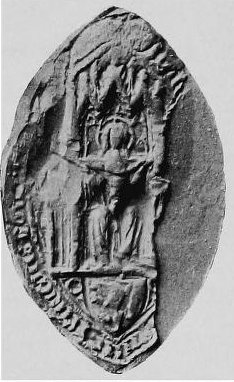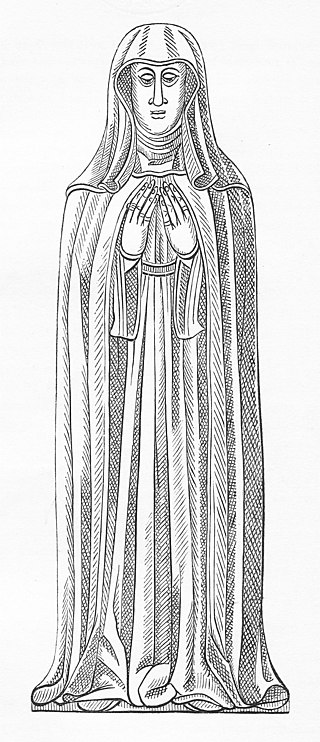Related Research Articles

Ainstable is a village and civil parish in the English county of Cumbria.

Arthington Priory was an English monastery which was home to a community of nuns in Arthington, West Yorkshire, founded in the mid-12th century. The priory land is occupied by a residence called "Arthington Hall", which was built around 1585, and little, if anything, remains of the priory. The site of the priory church is possibly now occupied by a farmhouse called The Nunnery. The community was the only one of nuns of the Cluniac congregation in Yorkshire and one of two in England. It was established through a grant by Peter de Arthington.
Amesbury Abbey was a Benedictine abbey of women at Amesbury in Wiltshire, England, founded by Queen Ælfthryth in about the year 979 on what may have been the site of an earlier monastery. The abbey was dissolved in 1177 by Henry II, who founded in its place a house of the Order of Fontevraud, known as Amesbury Priory.
Amesbury Priory was a Benedictine monastery at Amesbury in Wiltshire, England, belonging to the Order of Fontevraud. It was founded in 1177 to replace the earlier Amesbury Abbey, a Saxon foundation established about the year 979. The Anglo-Norman Amesbury Priory was disbanded at the Dissolution of the monasteries and ceased to exist as a monastic house in 1539.
Westwood Priory was a priory of Benedictine nuns founded in 1153, near Droitwich, Worcestershire, England. It was a daughter house of Fontevraud Abbey, seized by the English crown in 1537 during the Dissolution of the monasteries.
Hedingham Priory was a Benedictine nunnery in Castle Hedingham, Essex, founded in or before 1190 by Aubrey de Vere, 1st Earl of Oxford, perhaps in partnership with his third wife, Agnes of Essex. It was dedicated to the Virgin Mary, St. James, and the Holy Cross.

Markyate Priory was a Benedictine priory in Bedfordshire, England. It was established in 1145 and disestablished in 1537.

Originally called the nunnery of Lekeley from the name of the land it was built upon, the former nunnery of Seaton is to the north of the parish of Bootle, Cumbria, England.

King's Mead Priory was a Benedictine Priory situated west of Derby, in the area currently known as Nun's Street, or Nun's Green. It was the only Benedictine Nunnery in Derbyshire.
Nunburnholme Priory was a priory of Benedictine nuns in the East Riding of Yorkshire, England. It was founded during the reign of Henry II of England by an ancestor of Robert de Merlay, lord of Morpeth. Except for its demesne, it possessed only little property in its surroundings. In 1313 the prioress claimed the monastery of Seton in Coupland as a cell of Nunburnholme. In 1521 only five nuns and the prioress lived here, and on 11 August 1536 the house was suppressed. It was valued as the poorest and smallest of the Benedictine nunneries in Yorkshire surviving until then.

Langley Priory is a former Benedictine nunnery in the civil parish of Isley cum Langley, in the North West Leicestershire district, in the county of Leicestershire, England. It is located around a mile and a half south of East Midlands Airport; around a mile from the village of Diseworth.
Stixwould Priory was a priory in Lincolnshire, England, a Cistercian nunnery founded by Lucy, countess of Chester, in 1135. The Mappa Mundi describes it as Gilbertine, but modern authors regard it as Premonstratensian. Originally suppressed in 1536, Benedictine nuns from Stainfield were then moved in by the King. In 1537 the nunnery was refounded for Premonstratensian canonesses, before being finally suppressed in 1539.
St. George's Priory, Thetford was a Benedictine priory on the Suffolk side of Thetford, England. It was located at the current site of the British Trust for Ornithology, South of Nuns Bridges Road.

Farewell Priory was a Benedictine nunnery near Lichfield in Staffordshire, England. Although it received considerable episcopal support, it was always small and poor. It was dissolved in 1527 as a by-product of Cardinal Wolsey's scheme to establish a college within Oxford University.

Flixton Priory was a nunnery under a prioress following the Augustinian rule, which formerly stood in the parish of Flixton in the north of the English county of Suffolk, about 3 miles (4.8 km) south-west of Bungay. It was founded by Margery de Creke in 1258, and was dissolved in 1536–37. It was the poorest of the nunneries within the Diocese of Norwich. The site of the priory, which was enclosed by a moat, was at the present Abbey Farm, where little apart from the position in the landscape and a small section of standing wall remain to be seen. It was scheduled as an ancient monument in 1953. It is privately owned and is not open to the public. It is suggested that some parts of the masonry may have been re-used in St Peter's Hall at St Peter, South Elmham.
Rusper Priory was a priory of Benedictine nuns in West Sussex, England.

Black Ladies Priory was a house of Benedictine nuns, located about 4 km west of Brewood in Staffordshire, on the northern edge of the hamlet of Kiddemore Green. Founded in the mid-12th century, it was a small, often struggling, house. It was dissolved in 1538, and a large house was built on the site in Tudor and Jacobean styles by the Giffard family of Chillington Hall. Much of this is incorporated in the present Black Ladies, a large, Grade II*-listed, private residence.
Ainstable is a civil parish in the Eden District, Cumbria, England. It contains 21 buildings that are recorded in the National Heritage List for England. Of these, one is listed at Grade I, the highest of the three grades, two are at Grade II*, the middle grade, and the others are at Grade II, the lowest grade. The parish contains the villages of Ainstable, Croglin and Newbiggin, the hamlets of Dale, Walmersyke, Ruckcroft and Longdales, part of the village of Armathwaite, and the surrounding countryside. The oldest listed building in the parish originated as a Benedictine Nunnery, and has been altered and since used for other purposes. The other listed buildings consist of houses, farmhouses and associated structures, a bridge, a war memorial, a lych gate, and two churches.

Agnes Jordan was the last pre-reformation Abbess of Syon Monastery. It was she who had to sign the deed of surrender on 25 November 1539 which brought to an abrupt end the life of the abbey and granted all its property and wealth to Henry VIII. She was the sister of Isabel Jordan, prioress and later abbess of Wilton Abbey.
Joan Harkey was the last English prioress of Ellerton Priory in Swaledale in Yorkshire.
References
- ↑ Houses of Benedictine nuns: The nunnery of Armathwaite, A History of the County of Cumberland: Volume 2 (1905), pp. 189-192. Ed J Wilson.
- ↑ According to Wilson, a drawing of the 'sanctuary stone or pillar at Nunnery,' is in B.M. Add. MS. 9642, ff. 91, 170. A dissertation with a picture of the stone was written by Mr. S. Pegge in the Gentleman's Magazine of 1755, pp. 440, 451
- ↑ "The Cistercians in Yorkshire: The dissolution of the monasteries". Digital Humanities Institute. University of Sheffield . Retrieved 13 August 2023.
- ↑ Historic England. "THE NUNNERY, Ainstable (1312417)". National Heritage List for England .
- ↑ The Buildings of England - Cumbria. Matthew Hyde and Nikolaus Pevsner, 2010.
- Houses of Benedictine nuns: The nunnery of Armathwaite, A History of the County of Cumberland: Volume 2 (1905), pp. 189–192. Ed J Wilson.